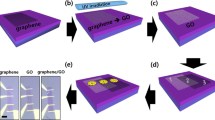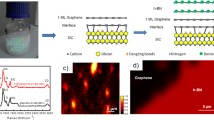Assembling layered materials in the form of vertically stacked heterostructures has enabled the combination of various properties from different two-dimensional (2D) materials, which is receiving a great deal of attention for investigating novel physical phenomena and emerging a facile way to fabricate promising highly tailored architectures. In this study, we employ Raman and photoluminescence (PL) spectroscopy to systematically investigate the influence of thickness on interlayer interaction in WSe2/n-layer graphene (WSe2/nL-Gr, n = 1, 2, 3, 4) heterostructures. It is found that the charge carrier concentration of graphene can be significantly affected by distinct interlayer coupling originated from heterostructure interface. The observed varying doping levels in graphene as layer number (nL) increases from 1L to 4L are quantitatively studied by considering the screening effects and band structure. On the other hand, the corresponding change of electronic band structure of WSe2 is further discussed after introducing graphene, PL intensity in WSe2/N-Gr heterostructures is quenched by more than 2 orders of magnitude which suggests ultra-efficient interlayer charge transfer occurs. Meanwhile, the various screening effects from graphene with different nL can account for the evolution of band structure of WSe2, which is in good agreement with the layer-dependent doping effect in graphene. This work offers a comprehensive investigation on nL dependence of interface coupling in WSe2/N-Gr heterostructures. Our observations also demonstrate that the physical properties of each component in heterostructures can be effectively tuned by the other one, which will drive the development of heterostructures in electronic and optoelectronic devices.
摘要
将不同性质的二维材料组装成垂直异质结构已经成为一种有效的研究新颖物理现象和制备可控结构的简单易行方法而被广泛关注。本文通过拉曼和光致发光光谱系统研究了石墨烯层数 (1至4层) 对二硒化钨/石墨烯异质结层间相互作用的影响, 揭示了不同层数石墨烯由于介电屏蔽效应和能带结构引起的不同层间相互作用而导致载流子浓度不同。另一方面研究了不同层数石墨烯对二硒化钨电子能带结构的影响, 异质结区域二硒化钨光致发光强度淬灭两个数量级, 表明石墨烯和二硒化钨之间高效率的电荷转移过程, 同时二硒化钨不同的能带结构改变源自于石墨烯层数依赖的介电屏蔽效应, 这与石墨烯中层数依赖的掺杂效应一致。本工作对二硒化钨/石墨烯中石墨烯层数依赖的不同层间耦合做了系统研究, 阐述了异质结构中材料层数对异质结特性的有效调控, 推动了异质结在电子器件和光电器件中的应用和发展。
Graphical abstract





Similar content being viewed by others
References
Novoselov KS, Geim AK, Morozov SV, Jiang D, Katsnelson MI, Grigorieva IV, Dubonos SV, Firsov AA. Two-dimensional gas of massless Dirac fermions in graphene. Nature. 2005;438(7065):197.
Zhu SJ, Song YB, Wang J, Wan H, Zhang Y, Ning Y, Yang B. Photoluminescence mechanism in graphene quantum dots: quantum confinement effect and surface/edge state. Nano Today. 2017;13:10.
Cho DH, Wang L, Kim JS, Lee GH, Kim ES, Lee S, Lee SY, Hone J, Lee C. Effect of surface morphology on friction of graphene on various substrates. Nanoscale. 2013;5(7):3063.
Novoselov KS, Geim AK, Morozov SV, Jiang D, Zhang Y, Dubonos SV, Grigorieva IV, Firsov AA. Electric field effect in atomically thin carbon films. Science. 2004;306(5696):666.
Hao M, Zeng W, Li YQ, Wang ZC. Three-dimensional graphene and its composite for gas sensors. Rare Met. 2021;40(6):1494.
Liang L, Meunier V. First-principles Raman spectra of MoS2, WS2 and their heterostructures. Nanoscale. 2014;6(10):5394.
Park JW, So HS, Kim S, Choi SH, Lee H, Lee J, Lee C, Kim Y. Optical properties of large-area ultrathin MoS2 films: evolution from a single layer to multilayers. J Appl Phys. 2014;116(18): 183509.
Geim AK, Grigorieva IV. Van der Waals heterostructures. Nature. 2013;499(7459):419.
Zhan L, Li CM, Gao PF, Huang CZ. AuNPs/graphene hybrids-based enzyme-free plasmonic immunoassay for respiratory syncytial virus detection. Journal of Analysis and Testing. 2021;5(3):203.
Liu JY, Zhang X, Lu G. Excitonic effect drives ultrafast dynamics in van der Waals heterostructures. Nano Lett. 2020;20(6):4631.
Jin CH, Ma EY, Karni O, Regan EC, Wang F, Heinz TF. Ultrafast dynamics in van der Waals heterostructures. Nat Nanotechnol. 2018;13(11):994.
Wong J, Jariwala D, Tagliabue G, Tat K, Davoyan AR, Sherrott MC, Atwater HA. High photovoltaic quantum efficiency in ultrathin van der Waals heterostructures. ACS Nano. 2017;11(7):7230.
Geng HJ, Yuan D, Yang Z, Tang ZJ, Zhang XW, Yang K, Su Y. Graphene van der Waals heterostructures for high-performance photodetectors. J Mater Chem C. 2019;7(36):11056.
Guo ZL, Miao NH, Zhou J, Sa BS, Sun Z. Strain-mediated type-I/type-II transition in MXene/Blue phosphorene van der Waals heterostructures for flexible optical/electronic devices. J Mater Chem C. 2017;5(4):978.
Ahmed S, Ding X, Murmu PP, Bao N, Liu R, Kennedy J, Wang L, Ding J, Wu T, Vinu A. High coercivity and magnetization in WSe2 by codoping Co and Nb. Small. 2020;16(12):1903173.
Karni O, Barré E, Lau SC, Gillen R, Ma EY, Kim B, Watanabe K, Taniguchi T, Maultzsch J, Barmak K. Infrared interlayer exciton emission in MoS2/WSe2 heterostructures. Phys Rev Lett. 2019;123(24): 247402.
Okada M, Kutana A, Kureishi Y, Kobayashi Y, Saito Y, Saito T, Watanabe K, Taniguchi T, Gupta S, Miyata Y. Direct and indirect interlayer excitons in a van der Waals heterostructure of hBN/WS2/MoS2/hBN. ACS Nano. 2018;12(3):2498.
Xing X, Zhao L, Zhang W, Wang Z, Su H, Chen H, Ma G, Dai J, Zhang W. Influence of a substrate on ultrafast interfacial charge transfer and dynamical interlayer excitons in monolayer WSe2/graphene heterostructures. Nanoscale. 2020;12(4):2498.
Nayak PK, Horbatenko Y, Ahn S, Kim G, Lee JU, Ma KY, Jang AR, Lim H, Kim D, Ryu S. Probing evolution of twist-angle-dependent interlayer excitons in MoSe2/WSe2 van der Waals heterostructures. ACS Nano. 2017;11(4):4041.
Yang B, Molina E, Kim J, Barroso D, Lohmann M, Liu Y, Xu Y, Wu R, Bartels L, Watanabe K. Effect of distance on photoluminescence quenching and proximity-induced spin–orbit coupling in graphene/WSe2 heterostructures. Nano Lett. 2018;18(6):3580.
Andersen K, Latini S, Thygesen KS. Dielectric genome of van der Waals heterostructures. Nano Lett. 2015;15(7):4616.
Gao S, Yang L, Spataru CD. Interlayer coupling and gate-tunable excitons in transition metal dichalcogenide heterostructures. Nano Lett. 2017;17(12):7809.
Bing D, Wang YY, Bai J, Du RX, Wu GQ, Liu LY. Optical contrast for identifying the thickness of two-dimensional materials. Opt Commun. 2018;406:128.
Graf D, Molitor F, Ensslin K, Stampfer C, Jungen A, Hierold C, Wirtz L. Spatially resolved raman spectroscopy of single- and few-layer graphene. Nano Lett. 2007;7(2):238.
Ferrari AC, Meyer JC, Scardaci V, Casiraghi C, Lazzeri M, Mauri F, Piscanec S, Jiang D, Novoselov KS, Roth S. Raman spectrum of graphene and graphene layers. Phys Rev Lett. 2006;97(18): 187401.
Ni Z, Wang Y, Yu T, Shen Z. Raman spectroscopy and imaging of graphene. Nano Res. 2008;1(4):273.
Deshpande MP, Solanki GK, Agarwal MK. Optical band gap in tungsten diselenide single crystals intercalated by indium. Mater Lett. 2000;43(1–2):66.
Froehlicher G, Lorchat E, Berciaud S. Charge versus energy transfer in atomically thin graphene-transition metal dichalcogenide van der Waals heterostructures. Phys Rev X. 2018;8(1): 011007.
Alyobi MM, Barnett CJ, Cobley RJ. Effects of thermal annealing on the properties of mechanically exfoliated suspended and on-substrate few-layer graphene. Curr Comput-Aided Drug Des. 2017;7(11):349.
Chakraborty B, Bera A, Muthu D, Bhowmick S, Waghmare UV, Sood A. Symmetry-dependent phonon renormalization in monolayer MoS2 transistor. Phys Rev B. 2012;85(16): 161403.
Hui YY, Liu X, Jie W, Chan NY, Hao J, Hsu YT, Li LJ, Guo W, Lau SP. Exceptional tunability of band energy in a compressively strained trilayer MoS2 sheet. ACS Nano. 2013;7(8):7126.
Zhang W, Huang JK, Chen CH, Chang YH, Cheng YJ, Li LJ. High-gain phototransistors based on a CVD MoS2 monolayer. Adv Mater Interfaces. 2013;25(25):3456.
Liu K, Yan Q, Chen M, Fan W, Sun Y, Suh J, Fu D, Lee S, Zhou J, Tongay S. Elastic properties of chemical-vapor-deposited monolayer MoS2, WS2, and their bilayer heterostructures. Nano Lett. 2014;14(9):5097.
Padilha J, Fazzio A, da Silva AJ. van der Waals heterostructure of phosphorene and graphene: tuning the Schottky barrier and doping by electrostatic gating. Phys Rev Lett. 2015;114(6): 066803.
Ju L, Velasco J, Huang E, Kahn S, Nosiglia C, Tsai HZ, Yang W, Taniguchi T, Watanabe K, Zhang Y. Photoinduced doping in heterostructures of graphene and boron nitride. Nat Nanotechnol. 2014;9(5):348.
Rao R, Islam AE, Singh S, Berry R, Kawakami RK, Maruyama B, Katoch J. Spectroscopic evaluation of charge-transfer doping and strain in graphene/MoS2 heterostructures. Phys Rev B. 2019;99(19): 195401.
Wang H, Wang Y, Cao X, Feng M, Lan G. Vibrational properties of graphene and graphene layers. J Raman Spectrosc. 2009;40(12):1791.
Guinea F. Charge distribution and screening in layered graphene systems. Phys Rev B. 2007;75(23): 235433.
Das A, Chakraborty B, Piscanec S, Pisana S, Sood A, Ferrari A. Phonon renormalization in doped bilayer graphene. Phys Rev B. 2009;79(15): 155417.
Raja A, Chaves A, Yu J, Arefe G, Hill HM, Rigosi AF, Berkelbach TC, Nagler P, Schüller C, Korn T. Coulomb engineering of the bandgap and excitons in two-dimensional materials. Nat Commun. 2017;8(1):1.
Azizi A, Eichfeld S, Geschwind G, Zhang K, Jiang B, Mukherjee D, Hossain L, Piasecki AF, Kabius B, Robinson JA. Freestanding van der Waals heterostructures of graphene and transition metal dichalcogenides. ACS Nano. 2015;9(5):4882.
Lin YC, Chang CYS, Ghosh RK, Li J, Zhu H, Addou R, Diaconescu B, Ohta T, Peng X, Lu N. Atomically thin heterostructures based on single-layer tungsten diselenide and graphene. Nano Lett. 2014;14(12):6936.
Zhao M, Song P, Teng J. Electrically and optically tunable responses in graphene/transition-metal-dichalcogenide heterostructures. ACS Appl Mater Interfaces. 2018;10(50):44102.
Acknowledgements
This study was financially supported by the National Key R&D Program of China (No. 2018YFA0703700), the National Natural Science Foundation of China (Nos. 61774040 and 61774042), Shanghai Municipal Natural Science Foundation (No. 20ZR1403200), Shanghai Municipal Science and Technology Commission (No. 18JC1410300), Fudan University-CIOMP Joint Fund (No. FC2018-002), the National Young 1000 Talent Plan of China, “First-Class Construction” Project of Fudan University (No. XM03170477) and the State Key Laboratory of ASIC & System, Fudan University (No. 2018MS001).
Author information
Authors and Affiliations
Corresponding authors
Ethics declarations
Conflict of interests
The authors declare that they have no conflict of interest.
Supplementary Information
Below is the link to the electronic supplementary material.
Rights and permissions
About this article
Cite this article
Shan, YB., Yue, XF., Chen, JJ. et al. Revealing layer-dependent interlayer interactions by doping effect on graphene in WSe2/N-layer graphene heterostructures using Raman and photoluminescence spectroscopy. Rare Met. 41, 3646–3653 (2022). https://doi.org/10.1007/s12598-022-02053-7
Received:
Revised:
Accepted:
Published:
Issue Date:
DOI: https://doi.org/10.1007/s12598-022-02053-7




